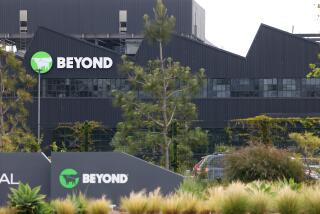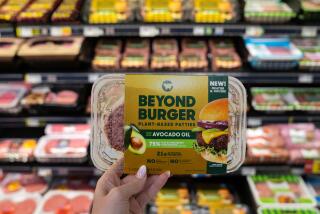Petri dish certified
- Share via
THE new good-for-you meat won’t be pork or grass-fed beef, and it won’t be made of soy. If the efforts of a few future-minded scientists succeed, it will taste and look like old-fashioned meat -- only it’ll be raised in a lab, not on a farm.
Several groups of scientists are cultivating edible meat in dishes from animal muscle cells. The technology, which involves choosing the right starter cells, stimulating and fine-tuning their growth for taste, texture and nutrients, has a way -- a long way -- to go before meat could hit supermarkets. But these researchers insist it will be a more efficient way to produce a staple of the American diet -- and will make meat healthier to boot.
For the record:
12:00 a.m. June 16, 2006 For The Record
Los Angeles Times Friday June 16, 2006 Home Edition Main News Part A Page 2 National Desk 1 inches; 44 words Type of Material: Correction
Petri meat: A May 22 Health article about attempts to grow meat in the laboratory said that chicken heart muscle was grown in a flask for more than 30 years. In fact, scientists later concluded that the culture was probably contaminated with new cells.
For The Record
Los Angeles Times Monday June 19, 2006 Home Edition Health Part F Page 7 Features Desk 1 inches; 44 words Type of Material: Correction
Petri meat: A May 22 Health story about attempts to grow meat in the laboratory said that chicken heart muscle was grown in a flask for more than 30 years. In fact, scientists later concluded that the culture was likely contaminated with new cells.
Growing lab meat, they say, will mean scientists can control levels and types of fats (such as omega 3 fatty acids), protein and other substances and produce a product less likely to be contaminated with such food-poisoning culprits as E. coli.
“Suddenly a McDonald’s breakfast sausage patty could protect you from heart disease instead of giving you heart disease,” says Robert Lawrence, director of the Center for a Livable Future at the Bloomberg School of Public Health at Johns Hopkins University.
But scientists who study the old-fashioned kind of meat are skeptical. “It’ll never be practical,” says Yu Bang Lee, professor of animal science and muscle biology at UC Davis. It is just too technically and financially difficult, he says.
Meat, after all, is not simply a mass of muscle cells; it’s a complex tissue comprised of fat, nerves, blood vessels and connective tissue. Each cell type plays a role in the flavor and mouth-feel of a chicken cutlet, club steak or fillet of fish, says John Killefer, associate professor of meat science at the University of Illinois at Urbana-Champaign. Mimicking this structure is crucial if you want your product to be palatable.
Producing meat in a lab dish is far from a new idea. In 1912, French scientist Alexis Carrel placed chicken heart tissue in a flask of nutrients. The muscle cells grew for more than 30 years -- outliving Carrel himself.
In 1932, Winston Churchill wrote that by the 1980s people would “escape the absurdity of growing a whole chicken” by growing only desired parts -- like breasts and wings -- in the lab.
It was not his finest prediction. Only recently have resources been devoted to growing flesh; in July 2005, the basic methods being used were summarized in the journal Tissue Engineering.
To culture meat, scientists cut a small piece of muscle from a pig or fish, or use a few cells cultured in a lab. (Popular starters include embryonic myoblasts, which are cells destined to become muscle cells, or adult muscle “satellite” cells, which help muscle recover from injuries.) The cells are placed in a dish or bioreactor then “fed” with a fluid containing a combination of vitamins, minerals, amino acids, sugars, salts and growth factors.
Early success came in 2002, when Touro College biology professor Morris Benjaminson reported growing fish meat in the lab. He and his colleagues cultured the flesh using pieces of muscle tissue (about 20 square centimeters) harvested from anesthetized, living goldfish.
The tissues were doused with fibroblasts (cells that form connective tissue), incubated and nourished with either fetal cow serum, maitake or shiitake mushroom extract or fish meal.
Within a week, the fish muscles increased up to 89% in size.
Collaborator James Gilchriest, also a researcher at Touro, marinated a batch of the cultured fish -- which the researchers said “resembled fresh fish fillets” -- in olive oil, lemon and garlic before breading and deep-frying them.
“It smelled good,” said Benjaminson, but neither researcher subjected the results to a taste-test. They didn’t want to run afoul of Food and Drug Administration food safety regulations.
Since 2002, several other laboratories have reported promising results.
Despite many scientists’ skepticism, some entrepreneurs think the technology will prove perfect for items such as like sausages and chicken nuggets within as little as five years. Curing, smoking, spicing, grinding and additives can significantly transform (or disguise) the taste and texture of meat that goes into such processed products, says Jason Matheny, co-founder of Vive Inc., a newly-formed, Cambridge, Mass.-based biotech company devoted to lab-cultured meat.
Researchers are also trying to bring down cost: In vitro meat now runs $1,000 to $5,000 a pound to produce. Making it affordable will require cheaper nutrient sources and automating the growth process.
Vladimir Mironov, an associate professor at the Medical University of South Carolina who co-authored last year’s Tissue Engineering paper, said that in an era of bird flu, mad cow disease, increasing population densities and ambitions to travel to Mars, “tissue-engineered meat is the inescapable future of humanity.”
Meat scientist Killefer does agree on one point: In vitro meat may be perfect for space travel. “It’s just not feasible to take cattle and pigs into space, with all of their associated feed,” he says.
But he and other meat scientists doubt the technology will meet the demands of the consumer market any time soon, if ever. Cost and safety are major concerns.
Image is another issue: “Some folks are going to think this is like growing bacteria in a beaker in a lab,” Killefer says.
Mironov concurs: “Food consumption is a conservative cultural phenomenon. It can take several generations to change.”
More to Read
Eat your way across L.A.
Get our weekly Tasting Notes newsletter for reviews, news and more.
You may occasionally receive promotional content from the Los Angeles Times.










